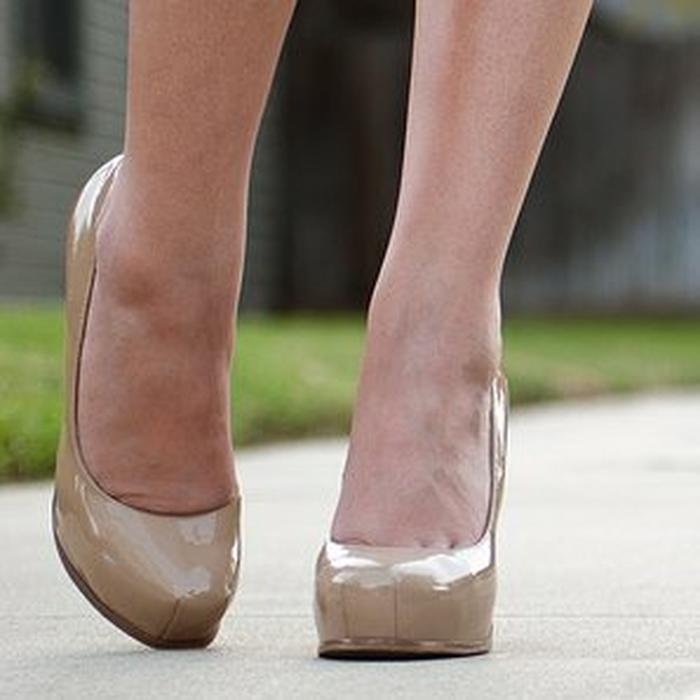
There’s a little extra pep in your step today. You beat your alarm clock to wake up, you didn’t have the usual trouble of finding something to wear, and you’ve decided, on this beautiful spring day, to walk to your morning meeting.
Then, bam! The heel of your shoe gets stuck in the crevice of the sidewalk. $#@*! Another city street has ruined your (not-so-inexpensive, mind you) heels.
Or has it? A little casualty—a broken heel, a scuff, too-slick soles, or even a not-exactly-perfect fit—doesn’t have to mean the end of your favorite pumps or peep-toes. We’ve put together a round-up of all the footwear-fixing solutions you’ll ever need—from free, easy tricks you can do at home to professional solutions that can save the day (and your shoes).
Scuffed Shoes
There’s nothing like a big black mark on your gorgeous nude pumps to make a statement—and not exactly the kind you want. Before you go too far treating the shoe, though, make sure the mark isn’t just dirt that can be scrubbed off. If you are stuck with a scuff, read on:
Free & Easy: Gently rub an eraser over the scuff—it may help the mark to disappear into the shoe (try this tip on leather, not patent leather).
Cheap & Cheerful: For leather shoes, use shoe polish that matches the color of the leather to cover the mark up ($4-$12/container), or a leather lotion, which gently cleans the shoe’s surface ($4-$25/bottle).
Costly (But Worth It): If it’s a bad scuff mark, or a really expensive pair of shoes, don’t DIY—head to the shoe repair shop. What you’ll be charged will vary depending on the brand of shoes and where you live, but it’s likely cheaper than buying a new pair.
Worn-Down Heels
Thanks to city sidewalks and hard office hallways, your heels never seem to have quite the shelf life you were hoping for. If a heel is completely shot, your shoe repair shop can put on a new rubber cap, or replace the heel altogether, for $8-15/shoe. But to prevent the wear and tear in the first place, try:
Free & Easy: Alternate shoes throughout the week (I know, twist your arm). The rate of wear is accelerated if you wear the same pair of shoes over and over again, so if you really love a pair of shoes, only wear it every few days.
Cheap & Cheerful: Have your shoemaker put rubber taps on your shoes. At approximately $2.50/pair (toe and heel taps), these little rubber gems will protect the toe and heel from wearing down.
Costly (But Worth It): If you do a lot of walking, get the SoleMates High Heeler ($9.95). The plastic Heeler fits snuggly onto high heels without damaging them, and prevents you from slipping into sidewalk cracks or subway grates. They come in four colors—clear, black, silver, and gold—and you simply remove them when you get to your destination.
Smooth, Slippery Soles
Have you ever walked off the elevators onto a marble entranceway or headed to the restroom in a restaurant and almost slipped? Hopefully, you caught yourself—but either way, it’s a scary (and embarrassing!) experience.
To prevent smooth, slippery soles from sabotaging your confident gait:
Free & Easy: Rub the soles of your shoes against a rough surface (i.e. coarse sandpaper, a rough patch of sidewalk, or an unsurfaced or stony driveway), to put some traction on them.
Cheap & Cheerful: Buy a bottle of cheap aerosol hairspray, spray it on the soles of your shoes, and let dry. A little stickiness goes a long way in preventing you from slipping and sliding.
Costly (But Worth It): Ask the shoemaker to add a sole protector—a piece of ribbed rubber placed on top of the smooth sole. It costs $18-$30, but it’s slip resistant, waterproof, and also protects against general wear and tear.
Just Too Tight or Uncomfortable
How many times have you sacrificed comfort (or, let’s be honest, tolerated outright pain) for style? Yes, there’s an easy fix for this one: Don’t buy uncomfortable shoes no matter how cute they are. But if you just couldn’t say no or you’re stuck with a pair that just doesn’t quite fit, try these tips:
Free & Easy: Remember that your feet tend to swell throughout the day, so save any pairs that are too tight for days you won’t be on your feet for hours. To prevent buying too-tight shoes in the first place, test them out on a hard surface. (Ever noticed that most shoe salons are carpeted? What an ingenious ploy to make us believe that the shoes feel great!)
Cheap & Cheerful: If your shoes are just too snug to wear, take them to your shoemaker for a quick stretch—sometimes it’s all you need to make them more comfortable. If you’re a regular customer, many shoemakers won’t charge you—otherwise, plan to pay $5-$8 for the pair.
Costly (But Worth It): Gel Insoles by Dr. Scholl’s—made for sneakers, flats, high heels, and now open-toe shoes—are a lifesaver for uncomfortable shoes. The layer of gel cushioning goes inside the shoe, offering an extra layer of protection between your foot and the sidewalk. A pair runs $10-$15 in the stores, but you can often find them online for less than $8.
Whether it’s your most comfortable pair of Payless boots, your trusted peep-toes from Nine West, or your favorite pair of Christian Louboutin stilettos—these tips can help you extend the life of many a pair of shoes. And when the general wear and tear becomes too noticeable and it’s time to say good-bye, remember: A fabulous new (long-lived) pair is just around the corner!